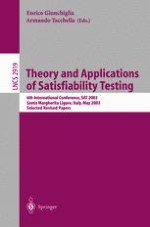2004 | OriginalPaper | Buchkapitel
Using Problem Structure for Efficient Clause Learning
verfasst von : Ashish Sabharwal, Paul Beame, Henry Kautz
Erschienen in: Theory and Applications of Satisfiability Testing
Verlag: Springer Berlin Heidelberg
Enthalten in: Professional Book Archive
Aktivieren Sie unsere intelligente Suche, um passende Fachinhalte oder Patente zu finden.
Wählen Sie Textabschnitte aus um mit Künstlicher Intelligenz passenden Patente zu finden. powered by
Markieren Sie Textabschnitte, um KI-gestützt weitere passende Inhalte zu finden. powered by
DPLL based clause learning algorithms for satisfiability testing are known to work very well in practice. However, like most branch-and-bound techniques, their performance depends heavily on the variable order used in making branching decisions. We propose a novel way of exploiting the underlying problem structure to guide clause learning algorithms toward faster solutions. The key idea is to use a higher level problem description, such as a graph or a PDDL specification, to generate a good branching sequence as an aid to SAT solvers. The sequence captures hierarchical structure that is lost in the CNF translation. We show that this leads to exponential speedups on grid and randomized pebbling problems. The ideas we use originate from the analysis of problem structure recently used in [1] to study clause learning from a theoretical perspective.
